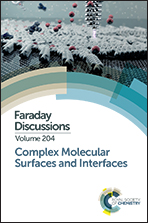The culture of HaCaT cells on liquid substrates is mediated by a mechanically strong liquid–liquid interface
Abstract
The mechanical properties of naturally-derived matrices and biomaterials are thought to play an important role in directing cell adhesion, spreading, motility, proliferation and differentiation. However, recent reports have indicated that cells may respond to local nanoscale physical cues, rather than bulk mechanical properties. We had previously reported that primary keratinocytes and mesenchymal stem cells did not seem to respond to the bulk mechanical properties of poly(dimethyl siloxane) (PDMS) substrates. In this study, we examine the mechanical properties of weakly crosslinked PDMS substrates and observe a liquid-like behaviour, with complete stress relaxation. We then report the observation that HaCaT cells, an epidermal cell line, proliferate readily at the surface of uncrosslinked liquid PDMS, as well as on low viscosity (0.77 cSt) fluorinated oil. These results are surprising, considering current views in the field of mechanotransduction on the importance of bulk mechanical properties, but we find that strong mechanical interfaces, presumably resulting from protein assembly, are formed at liquid–liquid interfaces for which cell adhesion and proliferation are observed. Hence our results suggest that cells sense the nanoscale mechanical properties of liquid–liquid interfaces and that such physical cues are sufficient to sustain the proliferation of adherent cells.
- This article is part of the themed collection: Complex Molecular Surfaces and Interfaces


 Please wait while we load your content...
Please wait while we load your content...